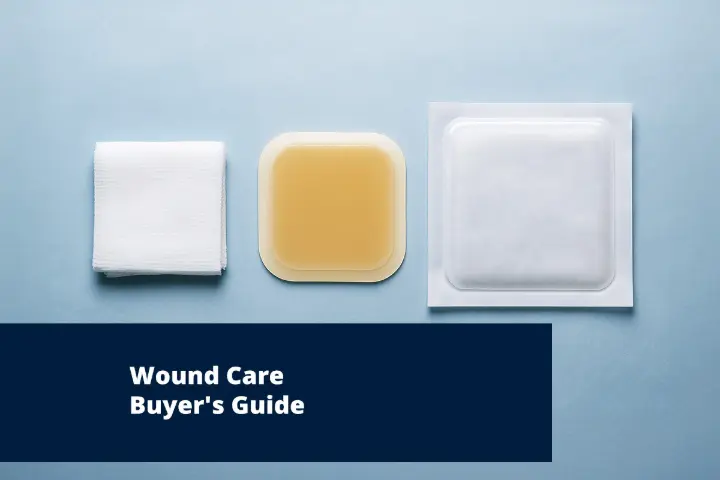Buyer’s Guide: Traditional vs. Advanced Wound Care
When you work in medical procurement, you don’t always get a front-row seat to the clinical side of things but you can talk to clinicians about their preferred products. Ask about the go-to wound care dressing and you’ll probably get different answers from different departments, because wound care isn't just about sealing up skin, it’s about healing, comfort, prevention, and sometimes, avoiding serious complications.
How do you choose between traditional and advanced wound care, and how can procurement best practices make a tangible difference?
Wound Care: A Balancing Act Between Simplicity and Science
At first glance, traditional wound care like gauze and tape seems cheaper and more familiar. It’s what many facilities keep on-hand in large quantities. But when you consider chronic wounds, pressure ulcers, or post-op care, the limitations of traditional materials become evident. Traditional materials often require frequent changing, offer limited absorption, and in some cases, might even disrupt healing due to repeated trauma on fragile skin.
This is where advanced wound care options start to justify their cost. Hydrocolloid, foam, alginate - each of these materials has its place. They manage exudate, reduce infection risk, and maintain the all-important moist environment needed for optimal healing. Clinicians, especially wound care specialists, tend to lean heavily on these dressings once they’ve used them in practice. There's a kind of “aha” moment when they see faster recovery, fewer dressing changes, and happier patients.
For procurement professionals, that shift toward advanced wound care might seem like a budget issue at first. But it’s not always about paying more, it’s about spending smarter. Fewer dressing changes mean fewer labor hours. Faster healing means shorter hospital stays. That’s medical procurement optimization in action.
Wound Dressings: Versatile Solutions for Protection and Healing
When it comes to product selection, MAP Medical offers a full range of wound dressings designed to support both acute and chronic wound management with over 240 SKUs in the category. Whether you're ordering for an OR, ICU, or outpatient clinic, MAP Medical has all the bases covered.
Product highlights:
- Hydrocolloid dressings that conform comfortably and stay put
- Foam options with high absorbency for moderate-to-heavy exudate
- Alginate dressings for wounds with significant drainage
- Breathable, gentle adhesives that are kind to compromised skin
- Sterile packaging, easy peel-and-stick practical formats
From a procurement angle, this variety in product selection helps support medical purchasing department best practices: matching the product to the wound type. It seems obvious, but many facilities still bulk-order generic gauze without considering the long-term costs - like waste, frequent changes, or worse, complications from inadequate healing environments.
Answering Common Procurement Desk Questions
One of the most frequent questions is how to decide which range of dressings to stock. A good starting point is to talk to clinical staff. Wound care nurses, infectious disease teams, surgeons. Ask what they actually use, what they avoid, and why. You’ll often find that a few key products do 80% of the work, and a couple of specialty items are needed for specific cases. Build your formulary around that.
Another common concern is how do we make sure staff use these dressings correctly? The best procurement strategy in the world doesn’t matter if dressings are being applied incorrectly or used in the wrong situation. Training sessions, product demos, quick-reference cards all can help, particularly if you are moving from traditional wound care to more advanced wound care supplies. When people understand how and why a product works, they’re more likely to use it properly.
What are the best practices for maintaining dressings? Simple things make the difference here. Ensure regular dressing changes, protect the wound area from contamination, and maintain a sterile stockpile that’s easy to access. These aren’t high-cost strategies, but they are high-impact because they lead to better results and quicker healing.
Wrapping It Up
Not every procurement decision feels like a life-or-death choice. That said, wound care is an important aspect of patient care where getting the wrong product can have a negative impact on healing time and infections. Choosing the right wound care dressing isn’t just a line item, it’s a clinical choice as well as a procurement department purchasing decision.
Whether you’re managing order cycles or evaluating supplier contracts, don’t underestimate the importance of wound care products. Look for real feedback from frontline staff and build a product list that reflects actual use. Wound care dressings can be more than just an item to reorder every few months, if you think about the implications for healing times and patient outcomes, then thought needs to be applied with a strategic approach to purchasing choices.
About MAP Medical
MAP Medical helps procurement teams find the supplies they need even when other distributors don’t have access to stock or can’t source hard to find items. With a product catalog featuring over 500,000 products from 3,000 manufacturers, MAP Medical supplies hospitals, acute care facilities, and educational & research labs with high quality products to match their exact requirements and budgets. Fast dispatch and delivery times, along with excellent customer service ensures the medical supply chain runs smoothly without interruption.
MAP Medical is more than just a supplier - we work as a strategic partner to enable every client that works with us to make tangible improvements in cost and time efficiencies. To find out more about how MAP Medical can help you, get in touch with our team today.



Buyer’s Guide: Traditional vs Advanced Wound Care